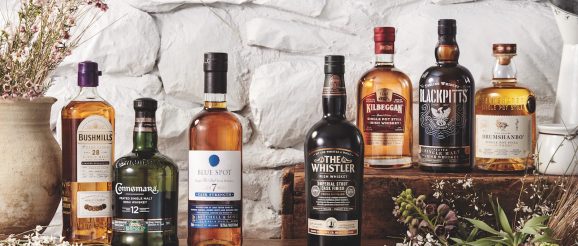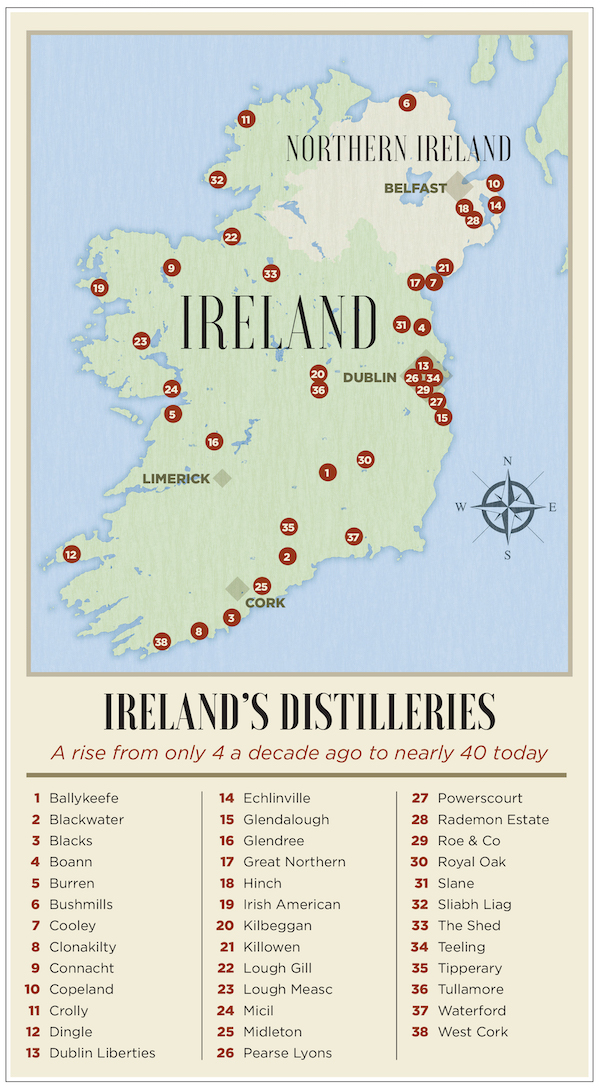The Great Irish Whiskey Revival Pairs Innovation and Tradition

The Irish whiskey restoration is in full swing. Over the last decade, the number of operational distilleries in Ireland has increased from 4 to nearly 40, and Irish whiskey’s soaring sales have made it the biggest growth story in the world. Following the collapse of Ireland’s economy in 2008, craft distilleries began sprouting up all over the island—occupied in abandoned spaces that formerly housed bakeries, sawmills, woolen mills, breweries, jam factories, and even a church. Within a decade, Dublin was reborn as the most vibrant whiskey city in the world, and Ireland’s distilleries hosted a million visitors in 2019 as whiskey lovers took notice.
During Irish whiskey’s lowest years of the 1960s and 1970s, blended expressions provided a straightforward route for rebuilding, and Irish blends, championed by Jameson, Bushmills, and Tullamore D.E.W., remain the driving force today. But now Ireland’s distillers are cultivating a far greater depth and diversity of styles, bringing Irish whiskey to a turning point in its long history. Here are four points in the whiskey space where Ireland’s distillers are looking to reach the next level of greatness—and they’re only a taste of what’s happening across the Emerald Isle.

Single Pot Still Whiskey
Single pot still Irish whiskey was a breakthrough winner in Whisky Advocate’s Top 20 whiskies of 2020, with three expressions—from Kilbeggan, Drumshanbo, and Teeling—making the list. This is a style anchored to Ireland, and has yet to be widely imitated in other nations. Brace yourself for a cascade of fresh single pot still whiskeys from the many new distilleries that have fired up their stills across Ireland in recent years.
Innovative Finishing
Ireland’s distillers are world leaders in whiskey finishing, with names like Teeling, West Cork, Glendalough, The Irishman, Tullamore D.E.W., Tyrconnell, The Whistler, and Jameson frequently expanding our horizons. Irish whiskey’s technical rules allow for a broad approach to finishing—which can come from either an alternative wood such as virgin Irish oak, or a cask previously seasoned by another spirit, like port, rum, or even tequila.
Peated Irish Whiskeys
Traditionally, peat was anathema to Irish whiskey, representing Scotland—even though Ireland possesses deep peat reserves. And through the ages, the Irish have had a close relationship with the land, cutting and lifting turf to burn. “If you go back far enough in Irish history, everything was peated—you and I would have been peated, as there would have been an open fire in the middle of the room and no chimney,” notes Alex Chasko, master distiller at Teeling Distillery in Dublin.
Whiskey of Great Age
Irish whiskey is starting to challenge the assumption that ultra-aged whisky is the preserve of Scotland and Japan. The decimation of the Irish whiskey industry in the mid-20th century left very few operational distilleries and precious little stock. Extraordinarily old casks are therefore rare, but the rising importance of Irish whiskeys of great age—at least 25 years and older—is still among the more interesting manifestations of Ireland’s whiskey renaissance.
The post The Great Irish Whiskey Revival Pairs Innovation and Tradition appeared first on Whisky Advocate.
